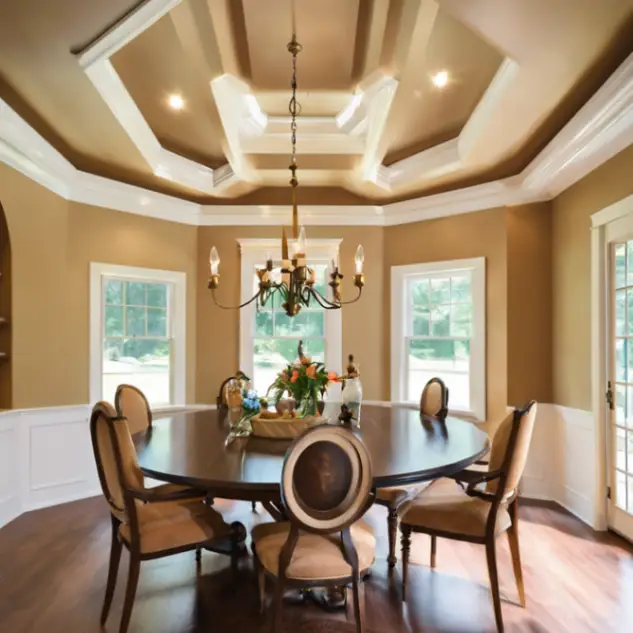A tray ceiling with crown molding dramatically enhances the elegance and visual appeal of the room. We will guide you through the process of transforming a standard dining room ceiling into a stunning focal point using crown molding. Whether you’re looking for ideas or step-by-step instructions, we’ve got you covered.
The initial state
Contents
The dining room we transformed originally had a tray ceiling painted the same color as the walls. While this created a cohesive look, the homeowner desired a more striking and elegant appearance.
Why it is called a tray ceiling?
A tray ceiling is like a large, inverted tray integrated into the ceiling of a room. And then, typically, the central portion of this design is elevated, ranging from 6 to 14 inches.
This architectural function includes a crucial flat detail that is recessed forward compared to the encircling perimeter, developing a stepped impact much like a tray’s raised edges.

This layout not best offers depth and size to a room but also permits innovative lighting and decorative alternatives, improving the overall aesthetic appeal of the distance.
What is the benefit of a tray ceiling?
- The illusion of space: Tray ceilings can make a small room feel larger due to the recessed area creating the illusion of more space.
- Design flexibility: Tray ceilings offer more design options compared to coffered ceilings.
Preparation steps
Repainting the ceiling: We started by repainting the tray ceiling white, a color that contrasts beautifully with the walls, making the ceiling stand out. You must use the same color as your walls, or a variant of the same color that is lighter or darker, and you have to avoid the colors that contrast with wall color.
Removing fixtures: Before installing the crown molding, we took down the existing light fixture, which was to be replaced after the completion of the molding work.
Molding Preparation
Painting molding: We recommend painting any molding before installation. This ensures an even coat and easier application.
Cutting and coping: Each piece of crown molding was carefully cut and coped for a perfect fit. Unlike simply cutting at 45-degree angles, coping the corners ensures that the molding fits tightly even if the walls and ceiling aren’t perfectly square.
Installation process
Upper tray crown molding: The first step was to install crown molding in the upper tray of the ceiling. This molding matched the design that would be used below, ensuring a cohesive look.

Enhancing with base molding: To create a more substantial and dramatic effect, we installed the lower crown molding on top of an upside-down base molding. This technique was used both in the upper tray and around the edges of the ceiling.

The final outcome
The dining room ceiling, now adorned with beautifully installed crown molding, became a stunning focal point. The double-layered molding added a significant visual impact, elevating the room’s overall aesthetic.
How to make a tray ceiling with crown molding
For those looking to undertake a similar project, here are the key steps summarized:
- Paint the Ceiling: Choose a contrasting color to make the tray ceiling stand out.
- Prepare the Molding: Paint and cope the molding pieces before installation.
- Install the upper tray molding: Ensure a snug fit with carefully cut and coped corners.
- Add base molding for impact: Place base molding upside down beneath the lower crown molding for a more dramatic look.
Conclusion:
A tray ceiling with crown molding is a complicated way to beautify any room’s aesthetic. Whether you are putting in a single-tray ceiling or a double-tray ceiling with crown molding, the key is in the instructions and attention to the element. With the proper technique, your ceiling can come to be a lovely architectural feature that adds beauty and value to your house.

